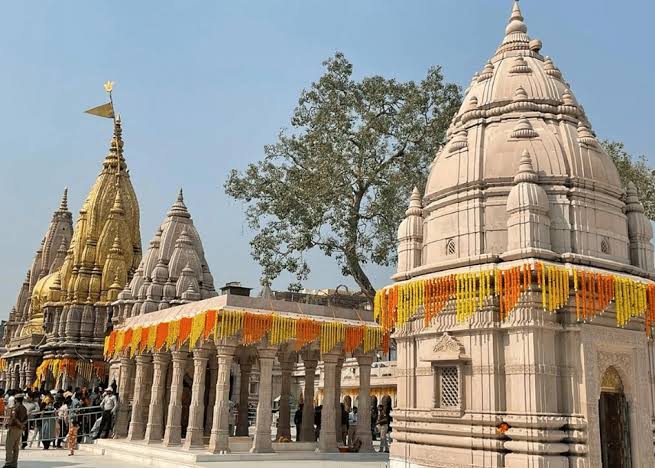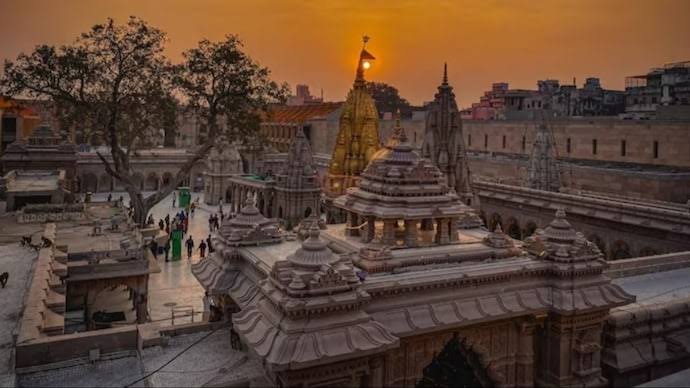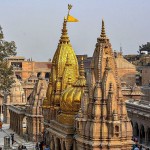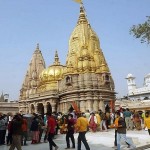The Kashi Vishwanath Temple, nestled in the heart of Varanasi, is not just a place of worship but a repository of history, culture, and spirituality that has transcended time. Revered as one of the holiest sites in Hinduism, this temple is dedicated to Lord Shiva, the destroyer and transformer within the Hindu trinity. While its religious significance is well-known, there are several lesser-known facts about the Kashi Vishwanath Temple that add to its mystique and allure. Here are ten intriguing facts about this sacred temple that will leave you fascinated.
1. The Early History: A Legacy of Resilience
The history of the Kashi Vishwanath Temple is a tale of resilience and reconstruction. The original temple is believed to have been built around 1490, though some legends suggest its existence dates back much earlier. Kashi, now known as Varanasi, has been a significant religious and cultural center for thousands of years. Throughout its long history, the temple has faced numerous invasions and destructions, particularly during the medieval period.
Kashi witnessed the rule of many kings, both famous and lesser-known, and was even under Buddhist control for some time. The city's strategic and religious importance made it a frequent target for invaders. The temple was plundered and destroyed multiple times by various rulers, particularly during the Mughal era, but each time, it was rebuilt by devoted Hindu kings and patrons. This cycle of destruction and reconstruction is a testament to the unwavering faith and resilience of the temple's devotees.
2. Mughal Emperor Akbar's Contribution: A Surprising Twist
While the Mughal dynasty is often associated with the destruction of Hindu temples, it is interesting to note that Mughal Emperor Akbar, known for his policy of religious tolerance, actually gave permission to build the original Kashi Vishwanath Temple. Akbar's reign marked a period of relative peace and cultural integration, and his support for the construction of Hindu temples was part of his broader policy of fostering harmony between different religious communities.
However, this gesture of goodwill was undone by his great-grandson Aurangzeb, the sixth Mughal emperor, who ruled over nearly the entire Indian subcontinent for 49 years. Aurangzeb, known for his orthodox Islamic policies, ordered the destruction of the temple in 1669 and built the Gyanvapi Mosque in its place. This act of destruction left a lasting scar on the Hindu community, but it also set the stage for one of the most remarkable stories of revival and restoration in Indian history.
3. The Restoration by Rani Ahilya Bai Holkar: A Queen's Devotion
The Kashi Vishwanath Temple owes its current form to the indomitable spirit of Rani Ahilya Bai Holkar, the Queen of Indore, who undertook its restoration in 1780. Known for her piety and administrative acumen, Rani Ahilya Bai was a devout follower of Lord Shiva. She took it upon herself to rebuild the temple after it had been destroyed by Aurangzeb. Her efforts were not just about reconstructing a physical structure but also about reviving the spiritual essence of the temple.
Rani Ahilya Bai's contribution to the temple's restoration is not just a historical footnote; it is a symbol of the enduring devotion and resilience of Hindu women in preserving their religious heritage. Today, the temple stands as a testament to her vision and commitment. The gold-plated spires and the sanctum sanctorum, where the Jyotirlinga is enshrined, were all part of her reconstruction efforts.
4. The Meaning Behind the Name: Vishvanatha, Ruler of the Universe
The Kashi Vishwanath Temple is not just any ordinary temple; it is dedicated to Vishvanatha or Vishveshvara, which means "Ruler of the Universe." This name reflects the temple's profound spiritual significance in Hinduism. Lord Shiva, as Vishvanatha, is believed to be the supreme deity who governs the entire cosmos. His presence in Kashi, one of the oldest living cities in the world, is considered especially auspicious.
Kashi itself is a name steeped in spiritual meaning. The city is also known as the "City of Light," where the light of knowledge and spirituality is believed to shine brightly. The combination of Vishvanatha and Kashi gives the temple its unique identity as a place where the divine and the earthly converge. The temple's name encapsulates its significance as a center of cosmic power and spiritual awakening.
5. The Sacred Jyotirlinga: A Manifestation of Shiva
The Kashi Vishwanath Temple is one of the 12 Jyotirlingas, the holiest of Shiva temples spread across India. A Jyotirlinga is a devotional representation of Lord Shiva, believed to be self-manifested, and is considered the most sacred form of Shiva worship. According to Hindu tradition, there are 64 Jyotirlingas, but only 12 of them are highly revered.
The Jyotirlinga at Kashi Vishwanath is said to have immense spiritual power. Devotees believe that a visit to this temple and a glimpse of the Jyotirlinga can cleanse one of all sins and lead to liberation (moksha). The temple is not just a place of ritualistic worship but a gateway to spiritual enlightenment. It is said that Lord Shiva himself resides in Kashi, making it a focal point of divine energy.
6. The Temple's Architectural Splendor: A Marvel of Ancient Design
The Kashi Vishwanath Temple is an architectural masterpiece that reflects the grandeur of ancient Indian temple design. The temple complex is adorned with intricate carvings, elaborate domes, and stunning sculptures that showcase the artistic brilliance of the period. The architecture is a blend of traditional Hindu styles with influences from the various dynasties that ruled over Kashi.
One of the most striking features of the temple is its spires, which are covered in gold. These golden spires add a touch of opulence to the temple's sacred aura and make it a visually captivating landmark. The sanctum sanctorum, where the Jyotirlinga is enshrined, is a place of profound spiritual energy. The temple's architecture is not just about aesthetics; it is designed to facilitate the flow of divine energy and create a space where devotees can connect with the divine.
7. Lord Shiva's Divine Intervention: The Legend of the "Well of Wisdom"
One of the most intriguing legends associated with the Kashi Vishwanath Temple is the story of how Lord Shiva thwarted Aurangzeb's plan to destroy the temple. According to this legend, when news reached the temple priests that Aurangzeb was planning to demolish the temple, they decided to hide the idol of Lord Shiva to protect it from destruction. The idol was concealed in a well, which later became known as the "Well of Wisdom" or Gyanvapi.
This well still exists today and is located between the Gyanvapi Mosque and the temple. It is considered a sacred site, and devotees often visit it as part of their pilgrimage to the Kashi Vishwanath Temple. The legend of the Well of Wisdom is a powerful reminder of the resilience and devotion of the temple's caretakers, who went to great lengths to preserve the sanctity of their faith in the face of adversity.
8. The Golden Domes: A Gift of Devotion
The three domes of the Kashi Vishwanath Temple, covered in gold, are among its most iconic features. These golden domes were the result of a generous donation by Maharaja Ranjit Singh, the ruler of the Sikh Empire, in 1835. Maharaja Ranjit Singh was a devout follower of Lord Shiva, and he contributed 1,000 kilograms of gold to cover the temple's spires. His contribution added a new dimension of grandeur to the temple, making it one of the most visually striking temples in India.
The golden domes not only enhance the temple's aesthetic appeal but also symbolize the unity of different Indian cultures. Maharaja Ranjit Singh's act of devotion is a testament to the inclusive nature of Hindu worship, where devotees from different backgrounds come together to honor the divine.

9. Spiritual Cleansing by the River Ganges: The Ritual of Purification
The Kashi Vishwanath Temple's location on the banks of the sacred River Ganges adds to its spiritual significance. The Ganges is considered the holiest river in Hinduism, and a ritual bath in its waters is believed to cleanse one of all sins. The temple's proximity to the Ganges allows devotees to perform this purifying ritual as part of their visit to the temple.
According to Hindu beliefs, a dip in the Ganges near the Kashi Vishwanath Temple is especially auspicious. It is said that the waters of the Ganges, combined with the divine energy of Lord Shiva, create a powerful purifying force that can lead to spiritual liberation. The ritual of bathing in the Ganges is not just a physical act of cleansing; it is a symbolic act of washing away the impurities of the soul.
10. A Symbol of Resilience and Devotion: The Temple's Enduring Legacy
The Kashi Vishwanath Temple stands as a symbol of resilience and devotion. Despite facing numerous invasions, destructions, and reconstructions, the temple has always been rebuilt, often with greater splendor than before. This cycle of destruction and renewal reflects the enduring spirit of Hinduism and the unbreakable bond between the devotees and their deity.
The temple's history is a microcosm of the larger history of Hinduism in India, marked by periods of adversity and resurgence. Each time the temple was destroyed, it was rebuilt by Hindu rulers and devotees, standing tall as a











